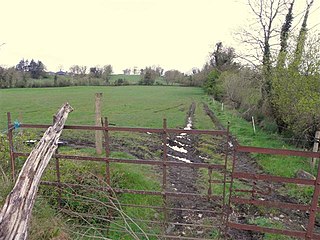Related Research Articles
Derrinlester is a townland in the civil parish of Kildallan, barony of Tullyhunco, County Cavan, Ireland.

Mackan is a townland in the civil parish of Kildallan, barony of Tullyhunco, County Cavan, Ireland.
Laheen is a townland in the civil parish of Killashandra, barony of Tullyhunco, County Cavan, Ireland.

Keilagh is a townland in the civil parish of Kildallan, barony of Tullyhunco, County Cavan, Ireland. It is sometimes confused with the nearby townland of Keelagh in which the town of Killeshandra is situate.
Claragh is a townland in the civil parish of Kildallan, barony of Tullyhunco, County Cavan, Ireland.
Drumcartagh is a townland in the civil parish of Kildallan, barony of Tullyhunco, County Cavan, Ireland. It is also called Diamondhill.
Disert is a townland in the civil parish of Kildallan, barony of Tullyhunco, County Cavan, Ireland.
Drumbo is a townland in the civil parish of Kildallan, barony of Tullyhunco, County Cavan, Ireland.
Gorteen is a townland in the civil parish of Kildallan, barony of Tullyhunco, County Cavan, Ireland. It is also called Gorteenagarry.
Clooneen is a townland in the civil parish of Kildallan, barony of Tullyhunco, County Cavan, Ireland.
Cornaclea is a townland in the civil parish of Kildallan, barony of Tullyhunco, County Cavan, Ireland. It is also called Tawlagh.
Makief is a townland in the civil parish of Kildallan, barony of Tullyhunco, County Cavan, Ireland. It is also called Hill or ‘The Hill’.
Drummully East is a townland in the civil parish of Kildallan, barony of Tullyhunco, County Cavan, Ireland.
Drummully West is a townland in the civil parish of Kildallan, barony of Tullyhunco, County Cavan, Ireland.

Gortnacleigh is a townland in the civil parish of Kildallan, barony of Tullyhunco, County Cavan, Ireland.
Drumcase is a townland in the civil parish of Kildallan, barony of Tullyhunco, County Cavan, Ireland. It is also called Drumrath.

Drumerdannan is a townland in the civil parish of Kildallan, barony of Tullyhunco, County Cavan, Ireland.
Glasstown is a townland in the civil parish of Kildallan, barony of Tullyhunco, County Cavan, Ireland. It is also called Port.

Drumbagh is a townland in the civil parish of Kildallan, barony of Tullyhunco, County Cavan, Ireland.

Cuillaghan is a townland in the civil parish of Drumlane, Barony of Loughtee Lower, County Cavan, Ireland.
References
- ↑ "Placenames Database of Ireland - Cloncose" . Retrieved 29 February 2012.
- ↑ "IreAtlas" . Retrieved 29 February 2012.
- ↑ "Image: 1609-hi_Clonyn.jpg, (815 × 1286 px)". cavantownlands.com. Retrieved 20 August 2018.
- ↑ "Inquisitionum in Officio Rotulorum Cancellariae Hiberniae Asservatarum Repertorium". command of his majesty King George IV. In pursuance of an address of the house of Commons of Great Britain (an Ireland). 5 September 1829 – via Google Books.
- ↑ "Calendar of the Carew manuscripts, preserved in the archi-episcopal library at Lambeth ." archive.org. Retrieved 20 August 2018.
- ↑ Inquisitionum in Officio Rotulorum Cancellariae Hiberniae Asservatarum Repertorium. command of his majesty King George IV. In pursuance of an address of the house of Commons of Great Britain (an Ireland). 1829. pp. 5–6. Retrieved 20 August 2018.
- ↑ "The Carvaghs" (PDF). 7 October 2011. Archived from the original (PDF) on 6 April 2016. Retrieved 20 August 2018.
- ↑ "The Tithe Applotment Books, 1823-37". titheapplotmentbooks.nationalarchives.ie. Retrieved 20 August 2018.
- ↑ "The Tithe Applotment Books, 1823-37". titheapplotmentbooks.nationalarchives.ie.
- ↑ "Townland of Cloncose" (PDF). nationalarchives.ie. Retrieved 1 March 2021.
- ↑ "Griffith's Valuation". askaboutireland.ie. Retrieved 20 August 2018.
- ↑ "National Archives: Census of Ireland 1901" . Retrieved 19 October 2016.
- ↑ "National Archives: Census of Ireland 1911" . Retrieved 19 October 2016.
